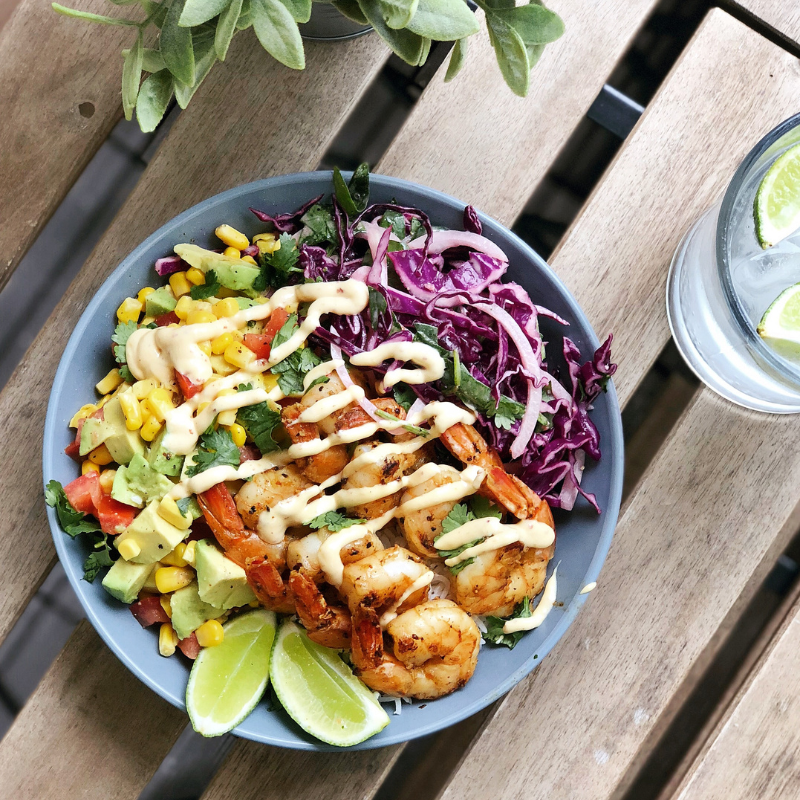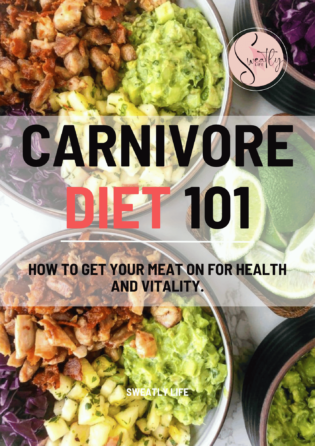
As a mom of 4, I know exactly what it’s like to gain and lose weight. I gained weight with each pregnancy, and I had to lose it each time after. Most ot the time, while I was breastfeeding, eating a clean, nutrient-dense diet was all it took for me to lose the baby weight. I focused on protein shakes (for lactation), as well as eliminating processed carbs, sugars and low-quality proteins to make sure I was fueling my body with nutrients to support breastfeeding. Fast forward to after my fouth baby, and I was left with a lingering 5-7lbs that didn’t want to come off. I think it was a combination of being older, busier with 4 kids, and just not paying close enough attention to my diet. I decided I should count my macros to fine-tune my diet and I also stuck with my Peloton workout plan while counting my macros and I saw results immediately.
As a certified nutrition coach and fitness professional, I naturally eat a very healthy diet. I love fruits, vegetables, salads, oatmeal bakes and protein shakes. I also know how powerful documenting your diet can be, because it opens your eyes to what you’re really eating. I realized right away how carb-heavy my diet was when I started counting macros. I thought I was eating enough protein, but in reality I was eating a lot of carbs. Because my body didn’t have that much protein, it wasn’t holding on to muscle that helps keep your metabolism fast and going strong. Eating dietary protein is really important to igniting protein synthesis and telling your body to hold on to muscle. Protein also helps you burn more calories during digestion, so it is a great nutrient for weight loss. It helps you feel full and satisfied on less calories.
When I started counting macros, I focused on leaner protein like chicken salads, egg whites, turkey roll ups and more, rather than fruit and nuts (high carb and fat snacks!). Right away my stomach leaned out a lot! I was able to follow my workout plan with my Peloton, and lose the last little bit of weight really fast.
I didn’t have to play with my macros too much, but it does take the right ratios to lose weight. If you aren’t sure where to start, I can give you a custom macro count with a nutrition plan, so you can get started right away!
Macros, short for macronutrients, are the nutrients your body needs in large amounts: carbohydrates, proteins, and fats. Each plays a unique role in fueling our bodies, supporting muscle growth, and aiding in fat loss. By dialing in on the right proportions of these essential nutrients, we can optimize our diet for better results. Trust me, nailing your macro ratios is the first step toward achieving those fitness goals with more precision and less guesswork.
Benefits of Counting Macros for Weight Loss:
Counting macros (macronutrients) can be beneficial for weight loss because it provides a structured approach to nutrition that helps ensure you’re getting the right balance of nutrients to support your goals. Here are some key reasons why counting macros can be effective for weight loss:
- Personalized Nutrition: By tracking your intake of proteins, carbohydrates, and fats, you can tailor your diet to meet your specific needs. This helps ensure that you’re consuming enough of each macronutrient to support muscle maintenance, energy levels, and overall health.
- Caloric Awareness: Counting macros inherently involves tracking calories since macronutrients (proteins, carbs, and fats) contribute to your total caloric intake. This can help create a caloric deficit, which is necessary for weight loss.
- Balanced Diet: Ensuring that you get the right balance of macronutrients can help prevent nutrient deficiencies and promote a more balanced diet. This can improve satiety, energy levels, and overall well-being, making it easier to stick to your weight loss plan.
- Muscle Preservation: Adequate protein intake is crucial for preserving lean muscle mass during weight loss. By counting macros, you can ensure that you’re consuming enough protein to maintain muscle, which is important for metabolism and overall body composition.
- Flexibility: Unlike strict calorie counting or fad diets, counting macros offers flexibility. You can still enjoy a variety of foods as long as they fit within your macro targets, which can make it easier to adhere to your diet in the long term.
- Improved Food Choices: Tracking macros often encourages healthier food choices as you aim to meet your protein, carb, and fat goals. This can lead to a diet rich in whole, nutrient-dense foods, which can support weight loss and overall health.
Overall, counting macros provides a comprehensive and flexible approach to dieting that can help you achieve your weight loss goals while maintaining a balanced and nutritious diet.
Understanding Macro Ratios
When I first embarked on my journey to shed some extra weight and gain muscle, I stumbled upon a game changer: macro ratios. You’ve probably heard about them, but let’s dive a bit deeper into what they actually mean for us. Macro ratios refer to the balance of carbs, fats, and protein we consume daily. Each plays a pivotal role in our body’s functioning. Carbohydrates, our primary energy source, fuel our workouts and recovery, while fats, especially the healthy ones like olive oil and monounsaturated fats, are crucial for hormone production and maintaining energy levels. But let’s not forget about protein – the building blocks of muscle tissue. Getting enough protein is essential for muscle growth and repair, especially if weight loss and muscle gain are your fitness goals. Customizing these macros to fit your activity level, body type, and specific goals can make a significant effect on your body composition. For me, finding that sweet spot was the first step toward achieving my best results.
Counting macros, short for macronutrients, involves tracking the amounts of proteins, carbohydrates, and fats you consume each day. These macronutrients are the primary sources of energy in your diet, and each plays a different role in your body:
- Proteins: Essential for building and repairing tissues, enzymes, and hormones. Proteins are found in foods like meat, fish, eggs, dairy, legumes, and nuts.
- Carbohydrates: The body’s main energy source. Carbs are found in foods like fruits, vegetables, grains, and legumes. They can be simple (sugars) or complex (fiber and starch).
- Fats: Important for energy storage, hormone production, and nutrient absorption. Healthy fats are found in foods like avocados, nuts, seeds, olive oil, and fatty fish.
How Counting Macros Works
- Determine Your Goals: Your macro needs will vary based on your goals (e.g., weight loss, muscle gain, maintenance), activity level, and personal preferences.
- Calculate Your Macros: Use a macro calculator or consult a nutritionist to determine your daily macro targets. This typically involves calculating your Total Daily Energy Expenditure (TDEE) and then dividing it into percentages for each macronutrient.
- Track Your Intake: Use a food diary or app to log everything you eat and drink, tracking the grams of protein, carbohydrates, and fats.
- Adjust as Needed: Based on your progress and how you feel, you might need to adjust your macro targets to better align with your goals.
Example
If your goal is weight loss, you might start with a macro ratio like:
- 40% carbohydrates
- 30% protein
- 30% fat
If your daily calorie target is 2000 calories, this would translate to:
- 800 calories from carbohydrates (200 grams, since carbs have 4 calories per gram)
- 600 calories from protein (150 grams, since protein has 4 calories per gram)
- 600 calories from fat (about 67 grams, since fat has 9 calories per gram)
Benefits of Counting Macros
- Precision: Provides a detailed approach to ensure you’re eating the right balance of nutrients.
- Flexibility: Allows for a varied diet as long as you hit your macro targets.
- Nutrient Awareness: Encourages better food choices by focusing on nutrient density.
- Sustainability: Can be easier to stick to compared to restrictive diets since it allows for occasional treats within your macro limits.
Counting macros can be a powerful tool for achieving various fitness and health goals by promoting a balanced and nutrient-dense diet.
The Role of Calories
I must admit, navigating the maze of calorie deficit and surplus was a game-changer for me. Initially, I thought cutting down on my daily caloric intake was the holy grail of weight loss. However, it was not until I really dove into the specifics of body recomposition that the concept of energy balance truly clicked. It’s fascinating how it boils down to consuming fewer calories than you burn for fat loss and the opposite for muscle gain. Despite being swamped with numerous fitness goals and health conditions, understanding that my body’s total daily energy expenditure (TDEE) played a pivotal role in determining my caloric needs was a revelation. Crafting my nutritional plan around this, including just the right number of calories, turned out to be the cornerstone of my journey towards a leaner body mass and more defined muscle tissue.
Customizing Your Macros
I’ve been tweaking with my macro ratios for a while, aiming to strike that perfect balance for fat loss and muscle gain, and let me tell you, it’s like finding the sweet spot. The trick lies in customizing your macros according to your unique goals, activity level, and even body type. Hearing about this was a game changer for me. I started using an online macro calculator, and it felt like someone turned on the lights. It allowed me to input my daily calories, total daily energy expenditure, and even my preference for healthy fats, carbs, and protein intake. Suddenly, I wasn’t just guessing how much protein or how many grams of carbs I should eat; I had a clear path outlined based on my personal fitness goals and basal metabolic rate. It’s been an empowering journey, adjusting my food intake and seeing real results, both in terms of losing extra weight and gaining lean muscle mass. Truly, tailoring your macro ratios can feel complex, but with the right tools, it’s absolutely achievable.
Protein: The Building Block
Turning the flab into fab, and pumping up those muscles, I’ve learned that protein isn’t just another part of our diet; it’s the cornerstone of body recomposition. Think of it as the hero ingredient for muscle gain, with every gram acting like a brick in the fortress you’re building. From countless hours scouring online calculators to aligning my daily calories, what stood out was this: for optimal muscle growth, aligning my protein intake to about a gram per pound of body weight does wonders. Whether it’s through grilled chicken or scoops of whey, ensuring my plate or shake had enough of this macronutrient became my daily mission. Trust me, steering your food intake with precision towards a higher protein diet paves the way not just for muscle building, but for launching you towards those fitness goals with rocket fuel.
I have a great low-carb food list that will help you know which foods to eat to help you keep your carbs and fat in check, with your protein higher!
Ultimate Low Carb Foods List Pdf Printable (2024)
Fats: Essential but Tricky
I’ve always had a bit of a love-hate relationship with fats. On one hand, they’re essential for hormone production and maintaining my energy levels throughout the day. I remember when I first learned how crucial healthy fats like olive oil and monounsaturated fats are for our bodies. It was a game-changer. They’re not just about keeping us full; they play a critical role in absorbing essential nutrients and supporting our cellular health. But here’s the tricky part – it’s so easy to get carried away. The line between enough dietary fat and too much fat intake is incredibly thin. It is really easy to eat too much fat because the serving sizes are super small. Also, fat get stored as fat immediately if you have glucose in your system, which if you eat any carbs you will have glucose in your system, so your dietary fat will be stored as fat. This is where a lower fat and higher carb and protein ratio typically works better because you can eat more, fell more full, and there is less fat to be stored as fat. This allows your body to let go of fat stores when calories are reduced just a bit.
Carbohydrates: Energy Source
Carbohydrates, the healthy and natural ones like fruits, vegetables, oats, beans and other real foods are amazing for your body. Your brain prefers to run off of glucose, so eating more carbs is usually easier than eating a lower carb, keto-like diet. Some people do really well on keto, so that is definitely an option, but I like that counting macros allows you to eat more carbs and protein, with a little bit of fat, rather than only high-fat foods. I tend to love carbs, so it works better for me! Carbs are also lower in calories and higher in vitamins and nutrients, so you can eat more volume for less calories. The right kind of calories are really important when it comes to losing weight, but also having energy for your workouts and living. Complex carbohydrates, like whole grains, became my go-to because they not only supplied me with sustained energy but also played a significant role in supporting muscle maintenance as I was also working on my fitness routine with Peloton!
My Peloton Workout Routine to Make Weight Loss Faster
I’ve been obsessed with Peloton for years now, and I have some great workout programs you can grab for free to get you started, and you can use to lose weight. I committed time to workout daily for at least 45 minutes, so if you can committ to that much time, your body will completely transform. I made sure I was combining weight training and strength workouts with my bike rides. Check out these workout plans to get you started, or grab my full, 8-week Peloton workout plan for weight loss to progress your transformation!
Peloton Diet Plan To Lose Weight + 8 Week Peloton Workout Plan Cardio + Strength

Finding Your Sweet Spot
Finding the sweet spot for your macro ratio often feels like a balancing act. But trust me when I say, the effort is worth it. You see, the best way to achieve fat loss and foster muscle gain isn’t about following a one-size-fits-all approach. It’s deeply personal. Whether it’s tweaking the grams of protein you consume, adjusting your total calorie intake, or finding the right mix of healthy fats and complex carbohydrates, the process is unique to you. I encourage you to experiment and make adjustments, listen to your body, and consult professionals if necessary. Your individual needs and responses will guide you to your best results. And remember, patience and consistency are your allies on this journey.
-
Sale!

4-Week Peloton Pilates Workout Plan
$12.99Original price was: $12.99.$8.99Current price is: $8.99. -
Sale!

Peloton Diet Plan To Lose Weight + 8 Week Peloton Workout Plan Cardio + Strength
$27.99Original price was: $27.99.$22.99Current price is: $22.99. -
Sale!

Canivore Diet Plan 101: Get Started
$7.99Original price was: $7.99.$4.99Current price is: $4.99. -



